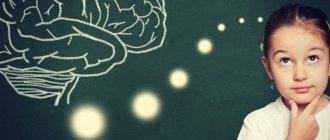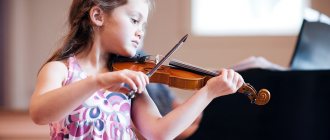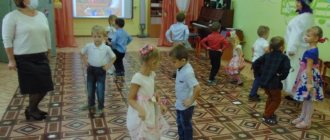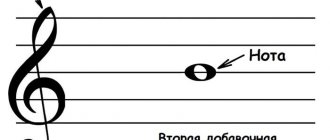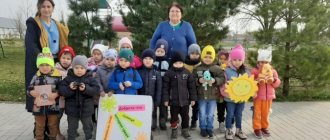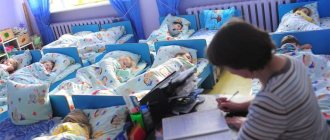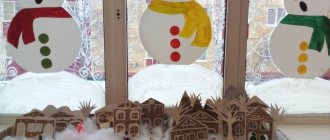Music lesson in the preparatory group “Listening to Music”
Introductory part
Topic: Listening to music. The visual nature of music.
Tasks:
- Introduce children to instrumental pieces.
- Learn to identify the two-part form of music.
- Strengthen the ability to convey the character of the work through movements.
Progress of the lesson
To the sound of marching music, children enter the hall, then perform exercises that reinforce expressive movement skills (springing, twirling, stamping with two feet) in pairs.
The music director sings: Hello, children! Answer: Hello!
Musical director: We’ll sit down, sit, and look at the pictures! (Pictures depicting sparrows and cars are attached to the magnetic board)
Musical director: Now let’s close our eyes, open our ears, listen carefully, imagine diligently!
(Listening to G. Fried’s musical work “Sparrows and the Car”)
Musical director:
- Guys, what is the character of our music?
- Who does the music sound like?
Look at the pictures and choose the one you need.
Now listen to the music again and show the desired picture that matches the first part of the piece and the desired picture that fits the second part of the piece. (children listen and show)
Musical director: What can you call our music? Children's answer...
Musical director: Now we’ll see how you can transform. When the first part sounds, you will depict the image of small birds in your movements, in the second part - the image of cars. (Children perform the appropriate movements) The music director praises the children.
Musical director: Now let’s remember what the nature of the play “Butterfly” is, which we listened to in the last lesson? Children's answer...
Musical director: Now tell me, is our music similar to the play “Butterfly”? Children's answer...
Also an interesting musical activity: GCD for musical activities (listening to music). Topic: Antoshka.
The game "Butterflies" is being played
Fake flowers the size of children are displayed (cornflower - blue, chamomile - white, dandelion - yellow, poppy - red), butterflies fly around the clearing to the song, to the words:
- Butterflies flew to a cornflower flower, a blue flower (the music stops, the butterflies gather in a circle around the desired flower, in this case it is a cornflower. The song about butterflies sounds again, with lyrics...);
- I met a daisy, cutie butterflies, a daisy flower, a white petal (the music stops, the butterflies gather around the desired flower, a daisy);
- The butterflies flew in and sat on the dandelion, the dandelion is the sun, the golden bottom (the music stops, the butterflies gather around the dandelion flower);
- The butterflies were flying, and they recognized the flower, it’s a red poppy - my friend, it’s like a festive flag (the music stops, the butterflies gather around the flower - a dandelion).
Musical director: Butterflies flew to the clearing and heard wonderful sounds.
"Spring Song" sounds.
Musical director: A song was played that conveys the spring mood and is similar in character to our sparrows and butterflies.
Repeat after me the words of this funny song:
The gentle sun, the sun of spring, The sun woke up a leaf from winter And the field woke up, and the forest woke up And under the warm sun, many miracles. (learning the first verse)
Musical director: And now, to light, graceful music, let’s try to express the spring mood in free dancing. (Children depict thawed butterflies, blades of grass growing and stretching upward, flying birds, awakened bear cubs, cheerful bunnies, the shining sun...)
Musical farewell: Goodbye children. Children: Bye to you.
Author: Kireeva Svetlana Borisovna Position: music director Place of work: MBDOU No. 299 Location: Krasnoyarsk
Abstract of OOD on music for children of the preparatory group
Summary of organized educational activities. Artistic and aesthetic development. Musical education.
“In the park of musical mysteries” (in a preparatory group for school)
Author: Zulfiya Raisovna Garipova, music director, MBDOU No. 13 “Ryabinka”, city of Aznakaevo, Republic of Tatarstan. Description: notes from a music lesson. This development will be of interest to preschool teachers. Goal : To develop children's creative abilities in all types of musical activities. Instill in children a love of music. Objectives: Educational: - consolidate children's knowledge about winter through listening to music and singing. — enrich vocabulary, teach children to express their feelings and thoughts about the piece they listened to. — exercise children in distinguishing rhythmic patterns. Developmental : - develop children's sense of rhythm and hearing. - develop a singing voice. -develop creative abilities: fantasy, imagination. - develop memory, attention, thinking. Educational: - cultivate love and interest in music. - cultivate independence, activity, and a friendly attitude towards each other. - make children want to listen to instrumental music. Methods and techniques: Verbal: questions, verbal explanation. Visual: showing illustrations, a portrait of the composer. Practical: musical games, creative tasks. Preliminary work: - conversation about winter changes in nature - examination of illustrations with a winter landscape. - learning songs, games, poems on a winter theme. Equipment : paintings of winter, portrait of A. Vivaldi, small and large snowflakes, illustration of a violin, notes cut out of cardboard, musical instruments: bells, triangles for each child, plumes for each child. Plan - organizational moment - greeting - exercise “Sleigh” - song creativity “Sing your name” - listening to “Winter” by A. Vivaldi from the cycle of seasons - singing “Blizzard” - musical game “Knock ri Zarnitskaya, Shumlin.
-music ri - result of the lesson Progress of the lesson.
Musical director : Hello guys. Guys, I am very glad to see you in the music room. I see you are in a good mood today and I want to invite you to the park of musical mysteries. In the magic park, you will receive magic notes for correct answers.
Musical director : Guys, what time of year is it now? Children: Winter. Musical director : That's right, winter has come, white snow has fallen, there are snowdrifts all around. Guys, how can we get to the park faster? Children: On skis, on ice, by car, on a sled. Musical director: That's right, guys, you can get there in different ways, but today we'll go on a sled. Guys, look at how to make a sled correctly (we show it together with the teacher). The boys stretch their arms back, and the girls hold on to them.
This is how you get a sled. Keep your back straight, heads raised. Exercise: “Sleigh”
Musical director : When we clap, we change the direction of movement, the girls will take us further (they perform the exercise to music). Musical director : So we got to the park. But you can only enter the park through these magical gates. Guys, what do you think we should do to get through. Children: Sing a song, dance, recite a poem. Musical director : There is a magical note here, now I’ll look in and read the assignment. “Guys, sing your beautiful names and the magic gates will let you through.”
Song creativity “Sing your name”
Target
: Develop children's creative abilities and ability to improvise.
(the guys chant the names and go through the gate). Musical director: Now let’s sit down on the chairs and take a rest from the road. Everyone sat down comfortably. Musical director : Oh, guys, another magical note here. Let's see what's written on it? “Dear guys, we are glad to see you in the park, but sitting on the chairs, we invite you to listen to a piece of music and determine its character. Musical director : Guys, we will listen to a musical work by foreign composer Antonio Vivaldi from the cycle of seasons - “Winter”. Listen carefully, you can close your eyes to concentrate.
And then tell me your impressions of what you imagined when you listened to this work. Listening: “Winter” by A. Vivaldi
Target
: Develop the ability to determine character and means of musical expression.
Musical director : Guys, what kind of winter did the composer want to depict in his work? Children: harsh...... Musical director: At first we heard even, abrupt chords - probably the composer depicted sharp gusts of wind that sweeps snow. Nature seems to be frozen. Guys, what was the character of the music? Children: Excited, anxious, restless, menacing, blizzard. Musical director : Guys, you correctly identified the character, but do you think this piece was performed by one instrument or many? Children: Lots of tools. Musical director : Correct, what is the simultaneous sound of several instruments called? Children: Orchestra. Musical director : Well done! Which instrument was the soloist? (if they don’t guess, I’ll ask a riddle) The smooth movements of the bow make the strings tremble The motive sounds from afar Sings about the moon wind How clear the sounds are overflowing There is joy and smiles in them A dreamy motive sounds It is played by ………. Children: violin. Musical director : Guys, a cold wind blew and a blizzard began to hum. Can you imagine how the wind howls? Children - oooo Musical director : Guys, everyone got up, now let's all remember together how to stand correctly while singing.
If you want to sing while standing, don’t move your head. Stand up beautifully, pull yourself up and smile calmly. Once! Inhale! And the Bird began to sing, the sound flew, Arms, shoulders - everything was free. It was pleasant and comfortable to sing. Chanting: "Blizzard."
Musical director : Another note came with the wind, now let's see what's on it.
Guys, there are snowflakes here. We are offered to play the musical game “Clap the Rhythm”. Be careful, big snowflakes will make long sounds, and small ones……. Musical and didactic game “Clap the Rhythm.”
Target:
develop rhythmic hearing.
Musical director : And now a musical riddle. (An excerpt of a song sounds). What is the name of this song? Children: “For the New Year.” Musical Director : What is the character of this song? Children - Cheerful, joyful, playful. Musical director : Now you and I will be artists and sing this song together, cheerfully.
Singing "New Year's Eve"
Target:
work on purity of intonation and articulation.
Musical director: The last note invites us to the dance floor. There are snowdrifts everywhere, so we’ll walk to the site. We walk through snowdrifts Through steep snowdrifts Raise your feet higher Make way for others. Musical director : How nice it is to watch snowflakes falling.
It's as if they are performing their dance, spinning in the air. So I suggest that the girls turn into a snowball for a while. And let each of you come up with and perform your own dance, take the plumes. In the meantime, the girls are getting ready to dance, the boys should take musical instruments. And what instruments are more suitable for dancing snowflakes. (if the boys find it difficult to answer when asking a riddle). He's sitting under the cap. Don't disturb him - he's silent. Just take it in your hands and rock it a little. You'll hear the chime of Ding-dong-dong. We will accompany the girls. Dance of snowflakes.
Musical director : Well done guys! You completed the task. Our trip to the park has come to an end. Now let's remember what we did in the park? Guys, look, almost everyone received magical notes. Those guys who don't have sheet music, don't be upset. In the next lessons you will be more active and will also receive notes. It's time for us to go back, let's say goodbye
We recommend watching:
Synopsis of a music lesson in the preparatory group “Sounds of Magic Music” Integrated GCD in music for kindergarten. Preparatory group Essay from the music director of a preschool educational institution Summary of educational activities on the musical development of children in the preparatory group
Similar articles:
Musical lesson in the senior group. Abstract
Musical-themed lesson on rhythm for the preparatory group of kindergarten
Music room scenario for children of senior and preparatory groups of preschool educational institutions
Scenario of musical leisure in the preparatory group of a preschool educational institution. Music by Shainsky
Musical festival in the preparatory group of kindergarten. Pushkin and music
» Musical and artistic activities of children under the conditions of the introduction of the Federal State Educational Standard
Independent musical activity of children
. Independent musical activity arises directly on the initiative of children. Each child tries in his own way to express what he learned in a music lesson; he persistently and with interest repeats an element of dance or selects a melody on a musical instrument, etc. Such exercises become a continuation of classes, they can be considered as elements of self-learning. A connection is established with the lessons, especially if, while teaching the child, the teacher develops his skill of independent action. For example, children are asked to sing a song unaccompanied in a key that is convenient for them or to compose their own version of some kind of formation, round dance, etc.
Children can express themselves in especially varied ways in role-playing games based on vivid impressions after a holiday of entertainment, music classes, watching TV shows, etc. These include “concert” games, “musical activities”, “riddles”, etc.
While observing children's games, the teacher constantly guides and tactfully helps them in creative independent activities, taking into account the interests and abilities of each. It is also necessary to create appropriate conditions: determine a place in the group room where children can play music and act freely; select a sufficient amount of gaming material. Independent musical activity is the result of learning in classes, acquired musical impressions at holidays and entertainment, and arises on the basis of the experience accumulated by the child.
Music during children's games.
In their free time, children often play games in which music plays a significant role. For example, when playing “concert”, “musical activity”, “circus”, etc., children remember and perform familiar songs, dances, round dances, improvise, composing their own songs and selecting them on a metallophone or other musical instrument. Even if children play games that are not related to music, music and a variety of musical accompaniment can also take place in them. Thus, children often use various musical instruments to give a signal for the departure of a train or ship. A cheerful song sung by children can accompany their “journey” by car. Boys, playing “soldier”, clearly march to the sound of a drum, “accompany” themselves by tapping out the rhythmic pattern of the song using cubes, sticks, etc.
Musical and didactic games play a significant role in the musical education of children
which develop an ear for music, the child’s creative abilities, and help to master the elements of musical notation in a playful way. Some of them are previously learned in class. In everyday life, the teacher repeats, reinforces these games with the children and introduces them to new ones.
